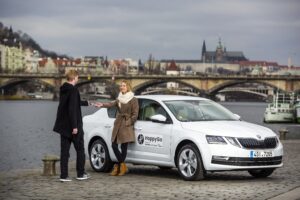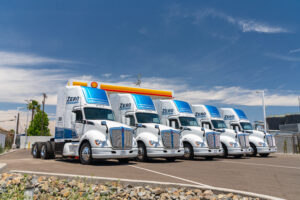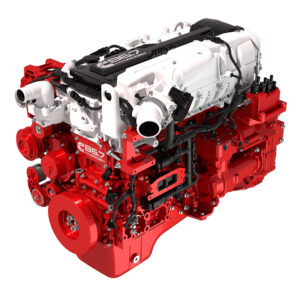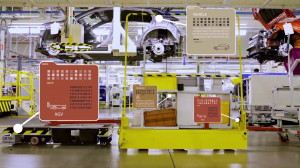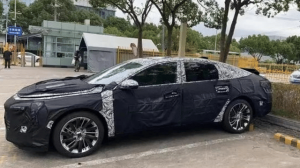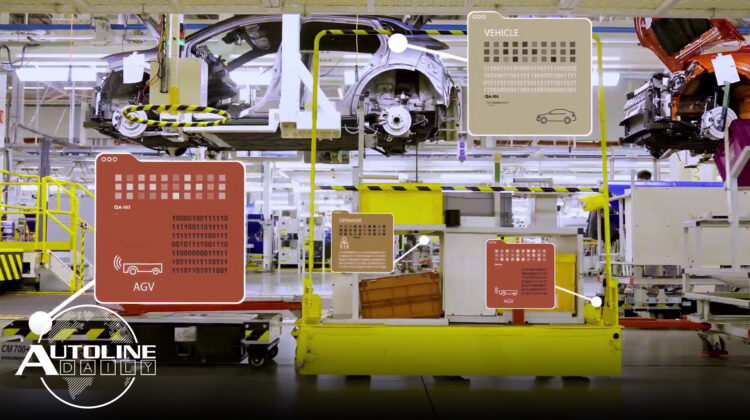

Follow us on social media:
Runtime: 10:15
0:00 GM to Lay Out EV Profitability Plan
0:51 Hyundai Will Open VTOL Hub in Indonesia
1:34 Ford Using Connected Data to Improve Insurance
2:46 Would You Let Others Drive Your Car for $215/Month?
3:34 Toyota HD Fuel Cell Production Starts Next Year
4:43 Cummins Signs Deal w/ Tata for Hydrogen ICEs
5:08 Renault Creates Metaverse for Manufacturing
6:38 New Buick LaCrosse to Wear Wildcat Face
7:15 EV Startups Scramble to Stay Alive
8:02 What is This Ukrainian War Vehicle?
8:42 U.S. V2X Test Improved Road Safety
Visit our sponsors to thank them for their support of Autoline Daily: Bridgestone, Intrepid Control Systems, and Schaeffler.
This is Autoline Daily, the show dedicated to enthusiasts of the global automotive industry.
GM WILL LAY OUT EV PROFITABILITY PLAN
General Motors has ambitious goals to sell 1 million electric vehicles in North America in 2025. The automaker is on pace to sell just 44,000 EVs this year in the U.S. But Bloomberg reports that CEO Mary Barra will tell investors later this week that GM’s EV lineup will be profitable by 2025 and will share details about how they will make that happen. Barra will also reveal how GM will cover investments in battery plants and assembly, while boosting margins for its Ultium batteries. GM’s EV push will really start next year, when Chevy will launch electric versions of the Silverado, Blazer and Equinox.
HYUNDAI OPENING VTOL HUB IN INDONESIA
VTOLs or vertical takeoff and landing aircraft continue to make progress. Last week, France opened a VTOL hub in Paris with the goal of starting flights in time for the 2024 Summer Olympics in Paris. And now the Hyundai Group has signed a memorandum of understanding to create a VTOL or what it calls advanced air mobility ecosystem in Indonesia. The project will begin with demonstrations and test flights in the city of Nusantara, Indonesia’s future capital city that replaces Jakarta in 2024. And based on the success of this project, Hyundai will expand its services regionally and then globally.
FORD USING CONNECTED DATA TO IMPROVE INSURANCE
Ford is giving customers the chance to save money on car insurance, as long as they’re willing to give up a bit of their privacy. The automaker is partnering with CerebrumX to use connected vehicle data to monitor driving behavior, which insurers can use to create policies for the owner. The connected vehicle tech provides more accurate and reliable driving data, plus no additional hardware or apps are needed. The service, which customers must opt in to, is available to Ford and Lincoln vehicles with connected car technology. So the safer you drive, the less you’ll have to pay for insurance.
HOPPYGO RENTERS EARN $215/MONTH
Would you let other people drive your car for a little over $215 or 208 euros a month? That’s what private owners earned on Skoda’s peer-to-peer car-sharing platform between July and October of this year. Called HoppyGo, it allows private owners to sign up their vehicle for the service and then other people can rent it. The idea is you can get access to the type of vehicle you need when you need it. While Skoda doesn’t say how many times a vehicle was rented out to earn that amount, it says the average rental lasts just under 5 days. HoppyGo offers brands outside of Skoda as well and operates in the Czech Republic, Slovakia and Poland with around 180,000 users.
TOYOTA STARTING HD FUEL CELL PRODUCTION NEXT YEAR
To us fuel cell applications seem to make the most sense for big commercial vehicles and while companies, like Toyota, that are involved in this space don’t even know themselves when the technology will replace diesel – it admits it might not be until 2027 or 2028 – they are preparing for that day. After wrapping up a years-long pilot at ports in California, Toyota is going to start production of fuel cell modules for heavy-duty applications next year at its plant in Kentucky. It says the fuel cell trucks used in the pilot tests had a range of 300 miles, but it expects newer versions to get closer to 400 miles and with bigger tanks that could go even higher. If a refueling network can be built, there could be a real market for these trucks. Heavy-duty commercial vehicle maker Kenworth, who partnered with Toyota on the tests, says there’s less than 1,000 zero emission trucks are being produced today, but by 2030 it thinks that will climb to more than 70,000 and then to over 180,000 in 2040.
CUMMINS TO SUPPLY TATA WITH HYDROGEN ICEs
Speaking of fuel cells, Cummins, which is famous for its diesel engines, announced a partnership with India’s Tata Motors to design and develop hydrogen-powered internal combustion engines, fuel cells and battery electric systems. These zero emission solutions will be put into Tata commercial vehicles, but they didn’t say when that would start happening.
RENAULT CREATES METAVERSE FOR MANUFACTURING
The Renault Group says it launched the first industrial Metaverse. What does that mean? It has fully connected all of its production lines and most of its supply chains, so it can create a virtual world of its entire manufacturing footprint and control it in real time. For example, each facility has its own virtual twin and if Renault wanted to prep that facility for a new vehicle, it could work out all the issues in the virtual world before applying it to the factory floor. And it expects big benefits from the industrial Metaverse. By 2025, it will save Renault 320 million euros in various areas, plus 260 million euros in inventory savings, a 60% reduction in vehicle delivery times, a 50% lower carbon footprint in manufacturing and will contribute to reduced warranty costs.
NEW BUICK LACROSSE TO WEAR WILDCAT FACE
Buick no longer sells sedans in its home market. But China is a different story. Remember that beautiful concept car, the Wildcat, that Buick unveiled earlier this year? Well, it turns out that’s the inspiration for the next generation of the Buick Lacrosse which is sold in China. It probably won’t have the fastback roofline like the concept car, but the front end styling is probably what will go into production. Inside, the new Lacrosse will have the same screen on the instrument panel as the Buick GL8 Century minivan, which we think is also impressive from a styling standpoint.
EV STARTUPS SCRAMBLE TO STAY ALIVE
EV startups often live on the ragged edge but always have that “never say die” attitude. Arrival, the UK startup, warned investors this month that it only has enough cash on hand to last about a year. But Autoforecast Solutions reports that Arrival is scheduled to start making an electric van in North Carolina starting in January, 2024. And Faraday Future is trying to raise another $350 million to get its FF91 electric car into production. Autoforecast says it’s scheduled to start sending cars down the line next April. So the race is on. Both these companies are in a mad scramble to get the money they need to fire up their assembly plants. But the clock is ticking.
WHAT IS THIS UKRAINIAN WAR VEHICLE?
The war in Ukraine isn’t going the way that Vladimir Putin thought it would go. That’s because the Ukrainians have proven to be far more adaptable and innovative than the Russians ever believed they could be. Here’s a good example. Ukrainian soldiers took some kind of right-hand steer 2-door hatchback, tore off the doors and fenders, welded on a big grille guard, and removed the rear hatch to make room for a machine gunner. But what the heck is the car that they used? That’s what Autoline viewer Mike Novak wants to know. He sent this to us, and now we want to use the collective wisdom of all of you to figure out what it is.
U.S. V2X TEST IMPROVED SAFETY
Honda, Hyundai, Toyota and the U.S. DOT has concluded a connected vehicle test program that started in 2015 and we find some of the results pretty interesting. This was done using vehicle-to-vehicle and vehicle-to-infrastructure warnings on an expressway in Florida. Data shows the program prevented 21 potential pedestrian crashes, delivered 19 red light violation warnings, avoided 17 potential vehicle collisions, alerted 14 wrong-way drivers, and issued over 20,000 safety advisories, which we’re guessing are tickets. At first that didn’t seem like all that much to us, but then we remembered this is just one stretch of road in Florida. Imagine if it was spread out across the country?
MOST AUTOLINE VIEWERS WANT TESLA CHARGER AS STANDARD
Yesterday we asked you if the U.S. should scrap the CCS charger for EVs and just adopt Tesla’s system. It wasn’t a scientific poll or anything like that. But based on your comments, most of you think that Tesla’s plug and charging system is the way to go.
So thanks for your feedback, and with that we wrap up today’s Autoline Daily.
Thanks to our partner for embedding Autoline Daily on its website: WardsAuto.com
Seamus and Sean McElroy cover the latest news in the automotive industry for Autoline Daily.






